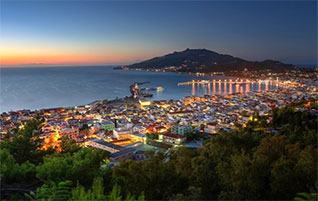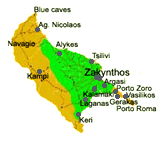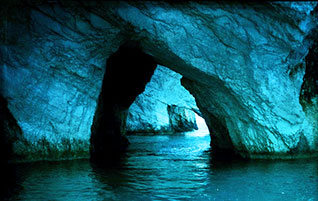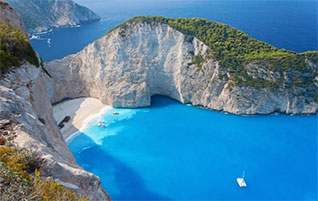|
Zante (Zakynthos) Island
The
island of
Zakynthos
is the third largest of the Ionian Islands. It is roughly 125 km in length
and covers an area of 406 sq km. It
s population is 38,000.
Zakynthos is mountainous forming steep and
inaccessible coasts, unlike the island's sandy beaches in the southeast. The
scenery is majestic, as the green slopes combine with the orchards and the
picturesque coasts. The protected species of sea turtles 'Caretta-Caretta' seek refuge on the southern sandy beaches of Zakynthos, in August, to bear their eggs. At night, when everything is quiet, the turtle emerges from the sea and digs a hole in the sand to keep their 120 eggs for 55 days.
History During antiquity, the people of Zakynthos worshipped Apollo and Diana. According to myth, Apollo sang, accompanied by his lyre and his attendants, because he was touched by the island's striking beauty. Diana went hunting in the dense forests. Pre-hisrorical-Ancient period According to testimonies from Pafsanias and Thucydides, the island of Zakynthos was inhabited for the first time in 1500 BC by Achaians from Psofida, in Arcadia. The island's acropolis was named after these Achaians. The new inhabitants worshipped the Olympian gods, especially Apollo, a fact corroborated by the era's coins which depict Apollo, or his sacred tripod. Later, the island of Zakynthos, along with Lefkada and Kefalonia, was conquered by Laertis, son of Arkissios, king of Kefalonia. The Zakynthians founded the powerful colonies Crete and Panos on the Iberian peninsula. In the Peloponnesian War, Zakynthos, supporting the Athenian Alliance, fought the Corinthians, particularly in the Battle of Lefkimi (434 BC) and in the expedition against Sicily. The island's defeat led to its conquest by Sparta. In the 3rd century BC, supporting the Aetolic Confederacy against king Philip V', the island of Zakynthos remained under Macedonian rule until it was conquered by the Romans. The Roman period In the late 3rd and early 2nd century BC, Zakynthos was ruled by the Roman Titus Falaminius. The conquerors had granted the Zakynthians with some autonomy regarding legislation. Although the island's inhabitants attempted repeatedly to dispense from the Roman domination, yet, whenever necessary, the Zakynthians fought together with the Romans, in order to successfully confront the attack of Archelaos and the pirate raids which were dealt with very successfully by the Roman Admiral Pompeius. Until 329 AD, the island of Zakynthos was part of the Roman Country of Achaia, along with Epirus, Peloponnesus and all the islands except Crete. Later, Zakynthos became part of the Country of Iliria. The decline of the Roman Empire urged several conquerors to make the most of the circumstances and people such as the Arabs, the Vandals, the Hans and the Goths attempted to conquer the island of Zakynthos. Byzantine period During the Byzantine period, Zakynthos was detached from the scheme of Logovardia and became part of the scheme of Kefalonia, as were the rest of the Ionian Islands. At the end of the Byzantine Period, the island was attacked by the Crusaders, the Normands and the Franks. This was when Christianity was introduced to the island, and the tradition claims that Maria Magdalene preached here in 34 AD, naming the village of Maries after herself. Frank rule In 1185 AD, Zakynthos and Kefalonia were detached from Byzantium, thus forming the "Palatian Country of Kefalonia and Zakynthos" which Goulielmo B' of Sicily granted to Margaritonis (alias Margaritos) from Vrindisio, today known in Italy as Brindisi. Throughout the period of Frank rule, the island's history was dominated by murders, conspiracies and intrigues, therefore prohibiting Zakynthos' development. In 1479, the Ottomans dominated the island of Zakynthos for five years. Venetian rule In 1484 Zakynthos came under Venetian Rule because of the treaty signed by the Venetians and the Ottomans. This period is characterized by a significant cultural development. The local features, the traditions and the local customs were influenced by the Italian traditions and customs. Thus, the infamous Ionian civilization was created. People obtained a higher quality of life and forgot their former, long period of poverty. French & Russian rule On July 4th 1797, the French conquered Zakynthos. Napoleon gave hope promising to free the Ionian Islands. This did not last for long, as in October of 1798, Russian-Turkish fleet disembarked on the island. These new conquerors reinstated the nobles' privileges. On March 21, 1800, the "Ionian State", which was under the Sultan's supervision, was founded in Constantinople. The government was made up exclusively of privileged rich nobles, which resulted in constant uprisings throughout the Ionian Islands. British Occupation The British Occupation became official with the signing of a decree founding the "United States of the Ionian Islands" on November 5, 1815, according to the treaty of Paris. This decree stated that the island's government would be under the supervision of England and the English Lord Commissioner. The British Occupation was characterized by constant political re-arrangements and changes. 1821 Greek revolution - Union The English unsuccessfully tried to prevent the Zakynthians from participating in the Greek Revolution. The Zakynthians offered money for the cause and men for the battles in the Peloponnese. After the recognition of Greece, the inhabitants of the Ionian Islands rose up and demanded changes in the constitution. Due to the crisis of the English policy in Greece and to popular demand, England resigned from the government of the Ionian Islands, which were united with the rest of Greece on September 23, 1863.
Places of interest Venetian Castle (Bochali) The Venetian Castle is situated is built upon the ruins of the acropolis and the cyclopean walls of the ancient town of Psofida, while, above the gate, one may distinguish the blazon of the lions of Agios Markos. The castle housed the town of Zakynthos, four catholic and eight orthodox churches. Byzantine museum Icons from the Byzantine Era to the 19th century, sculpts of the Hellenistic and the Byzantine Era, hagiographies of the Ionian art, and beautiful icon-stands from the island's churches. Works of great Zakynthian hagiograpers such as Tzanes, Panagiotis Doxaras, Nikolaos Koutouzis, Kandounis and Damaskinos. The most significant exhibits are the exterior of the church of Agios Andreas Volimon and the icon-stands from the churches of Agios Dimitrios and Pandokrator Blue Caves Situated in the area of "Aspros Vrahos" or "Krimnos", on the Skinari cape, the most northern part of the island, the cave, discovered in 1897. Its unique beauty, lies in the outstanding blue colour of its water, after which it was named.
Agia Mavra Situated in the village of Maherado, it is one of the most important churches of the island. Its architecture is of striking beauty. The Venetian bell tower calls melodiously to the pilgrims, especially in July when the festival of Agia Mavra takes place. Monastery of St George Gremon It is said that pirates destroyed the monastery in 1553, only to have it re-built in a Venetian style in the 17th century. The lodger, famous for its icon stand and roof, was renovated in 1803. Near the monastery, one can see the ruins of a castle which protected the area from pirate raids. St Dionyssios church It was built in 1708 and it was renovated half a century later, in 1764. In 1717, from the monastery of Strofades, the corpse of Agios Dionissios was transferred here, where it is kept in a silver carved reliquary. Many pilgrims from all over the island come here to pay their respects to the saint. The tall bell-tower, resembling the one of the church of Agios Markos in Venice, dominates the scenery. St Geogre Filikon Church The church is famous for the icon in front of which took their vows the members of Hetaeria and other fighters of the Greek Rovolution in 1821, such as Kolokotronis, Fotomaras and Nikitaras. Along with the icon, one can see the list with their names. Solomos and Kalvos mausoleums The most remarkable pieces are the mausoleums of Solomos and Kalvos, Zakynthos' greatest poets. In a separate room, one can see their personal belongings, as well as those of other notable figures in art and literature, such as Xenopoulos and Romas. Strani hill Dionyssios Solomos, while listening to the gun-fire during the siege of Mesolongi, wrote the poems "Free Besieged" and "Hymn to Liberty", which later became Greece's National Anthem. A statue in his honour was erected here. Municipal Library Substantial records concerning local news along with 55,000 volumes of books. In a separate area, the Gallery exhibits pictures and photographs, depicting the old life-style and history of Zakynthos. Navagio beach (the wreck) The most beautiful beach on the island. You can reach it from Porto Vromi (at the west) by boat. Kambi A unique sunset from an 160 m high place over the sea.
Transportation By air Regular -45 minute- flights from Athens (El. Venizelos airport). (Olympic Airlines +30 210 9666666) By bus & boat Buses from the station of Suburban Buses, 100 Kifissou str., Athens run daily to the port of Kylini (286 km- almost 5 hours), on the north-western coast of the Peloponnese. From Kylini ferries leaving for Zakynthos (18 n.m.- almost 1 hour).
|



